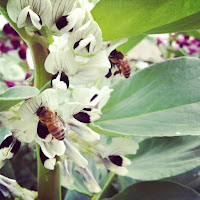Singapore Noodle soup
Ingredients:

2 tbsp sunflower oil
3-5 cloves of garlic, peeled and finely chopped
1 1/2 cm of ginger, peeled and finely chopped
1 white onion or 3 spring onions, chopped or in rings
piece of lemon grass, the marrow finely chopped, or 1 tsp grated lemon rind
vegetables, like courgette, carrot, green beans, bean sprouts, (chinese) cabbage, broccoli, clean and chopped
1 tbsp curry powder
1/2 can of coconut milk
2 packets of 2-minute noodles
2-4 eggs
Method:
- Heat the oil in a wok or large anti-stick pan. Add the garlic, ginger and onions. Stir fry until the onion is glazy.
- Add the lemon grass (if available)
- Add the vegetables, the harder types like carrot and broccoli first, stir frying all the time, the softer ones later, beansprouts last, until they get slightly soft
- Add the curry powder and mix well.
- Add the coconut milk and lemon rind if not using the lemon grass. Add water until the vegetables are well under.
- Bring to a boil. Add the noodles, the stock powder, that comes with it, to taste. Stir until the noodles start to loosen up.
- Add the eggs, letting them slide slowly into the soup. Use a laddle or spoon to spoon a little of the broth over the eggs. Cook the eggs to the hardness you like (runny or cooked through).
- Serve the soup immediately with chop sticks and chinese porcelain spoons (or just with spoons). As side dishes you can offer: soy sauce, fish sauce, chopped coriander, sweet chili sauce, sambol, fried onion etc.
Variations
- Marinate chicken filet in soy sauce, garlic and ginger for 30 min. Take out of the marinade and grill on BBQ or grill plate. Serve in thin slices on top of the soup, instead of the eggs.
- Same as above but use any type of pork. Pork belly is very good, but pork choppes are good as well.
- Grill or stir fry some prawns and serve on top of the soup.
- Any type of white fish can be substituted for the eggs and poached in the broth of the soup. You can marinate the fish first or use it pure.
2 knobs unsalted butter
1 small fresh onion, finely chopped
4 gloves galic, sliced
1 cm ginger, finely chopped
1 tsp ground coriander seeds
2 tsp ground cumin
1 tsp garam masala
1 tsp tumeric
2 jars of lentils (best are the red lentils, but any lentils will do)
2-3 red or green hot chillies, according to your taste. If fresh chilli is not available, use the small dried birds eye chili peppers
2 tomatoes, chopped
Method:
- Melt the butter in a deep non stick pan. Do not let it brown!
- Add the onion, garlic and ginger. Stir fry until the onion gets soft.
- Add the coriander, garam masala and cumin, stir.
- Add tumeric, lentils, chili and tomatoes.
- Add water if necessary (All ingredients should be just under)
- Bring to a boil and let simmer for 15-20 minutes.
- Serve with rice or naan bread.
Note: You can easily make your own mixture of garam masala: Mix 1 tbsp ground coriander, 1 1/2 tsp ground corander, 1 1/2 tsp gound cardamon, 1 1/2 tsp ground black pepper, 1 tsp ground cinnamon, 1/2 tsp ground cloves, 1/2 tsp ground nutmeg. Keep the mixture in a well seeled jar and you can use it when needed. The taste is even better when you use the whole seeds and grind them together in a coffee grinder.
Lassi, Indian yoghurt drink
There are many variations of Lassi yoghurt, but this one is my favourite. A treat at any time of the day.
Ingredients:
250 g (Greek) yoghurt
50 ml tepid water
200 ml cold water
2 tbsp sugar
the juice of 1 small lemon or lime
ice cubes
some mint leaves
Method:
- Dissolve the sugar in the tepid water.
- Add the rest of the ingredients, except the mint. Mix well with hand mixer or blender.
- Put ice cubes in four tall glasses and pour in the Lassi.
- Sprinkle with mint leaves and serve.
Bami (Indonesian fried noodles)
Ingredients:
3 packets of 2-minute noodles
2 tbsp sunflower oil
4 gloves of garlic, peeled
1 1/2 cm ginger, peeled and roughly chopped
1 onion, peeled and roughly chopped
4 pork belly chops, cut in cubes
3 large carrots, in thin strips
1/2 chinese cabbage, cut in strips
100 g bean sprouts
Soy sauce
sambal or minced chili peppers to taste
salt and ground white pepper to taste
Method:
- Cook the noodles according to instructions on the package, ommiting the seasoning. Drain.
- In a blender or mortar, mince the garlic, ginger and onion.
- Heat oil in a wok, stir fry the minced garlic mixture for a few minutes without letting it brown.
- Add the pork belly and fry until slightly brown.
- Add the carrots, Stir fry until the carrots begin to soften, then add the cabbage.
- Add a little water if the mixture gets to dry and starts to brown to quickly.
- Add bean sprouts, a splash of soy sauce, sambol (or minced red hit chili) to taste.
- Add the noodles, mixing everuthing well together. Add salt and ground white pepper to taste, or use one or two of the noodle seasoning packages.
- Serve the Bami with all or some of the following:

















